Reviewed by Glenn Erickson
One of the most coveted but elusive Euro-horror delights from the 'first wave' of the late 1950s and early '60s, ...Et mourir de plaisir (literally, "...and die of pleasure") made waves among fans of erotic films but faded along with the reputation of its director, Roger Vadim. The discoverer of Brigitte Bardot wasn't welcomed by the Cahiers du cinema critics, as his talent seemed more aligned with mild sexploitation than their brand of progressive cinema. In 1959 Vadim partly reversed that judgment with his updated version of Les Liaisons Dangereuses, a grabber of a drama with big stars Jeanne Moreau and Gérard Philipe as a married couple who callously use other people in their manipulative sex games. Moreau had the best exit scene, with a face burned with acid. Their prime victim is a young beauty played by Annette Stroyberg. The pouty Danish blonde became Vadim's new Trilby character. Their marriage endured through the production of Liaisons and Vadim's next effort, an ambitious erotic horror tale. ...Et mourir de plaisir is based on Sheridan Le Fanu's Carmilla, the (now) much exploited 'lesbian vampire' story. Actually, the gender love angle is somewhat ambiguous in the Le Fanu novella. Vadim makes it a sidebar issue in a complex psychological story.
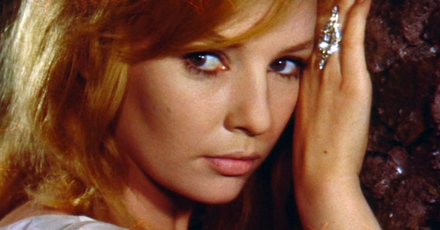
For many years fans of the film had to content themselves with provocative stills and references in film books. At one point Films Incorporated had good 16mm Technicolor & 'scope prints of Paramount's American version, titled Blood and Roses. 1 It wasn't until the middle 1990s that a feeble pan-scanned VHS of this same version appeared, at EP speed. My copy played exactly once before the cheap tape broke. I've since attended an American Cinematheque screening of a surviving 35mm print that unfortunately was very scratched and splice-ridden. And last year a web bootleg offered a very poor quality copy from a 2003 French TV airing -- a version that omitted almost all of the film's surreal dream sequence. 3
Now comes this German disc of appreciably better quality (more on that below) and language-friendly options for anyone who can play PAL Region 2 discs. The on-screen title is the German ...und vor Lust zu Sterben. By this writing availability may be running thin -- the release is listed as a Limited Edition.
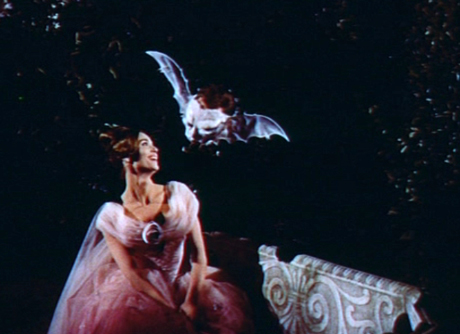
The story situates a Gothic tale in a modern setting. The wealthy Karnsteins live in a classy designer house, not a spooky mansion, but not far from their reflecting pool is an ancient ruin and former cemetery. Count Leopoldo De Karnstein (Mel Ferrer) is celebrating his coming wedding to the lovely Georgia Monteverdi (Elsa Martinelli), who he says "will save him from himself." A family business friend and a doctor are Leo's guests, along with his beloved cousin Carmilla (Annette Vadim [Stroyberg]), the most direct descendent of the Karnstein clan. In the 1600s the Karnsteins were denounced as vampires, and their corpses in the graveyard were mutilated and then burned. That the photogenic ruins no longer serve as a burial ground allows Leo to hire a fireworks expert to rig a big display there, for his engagement party (a bal masque --?). Already openly jealous of Georgia and disturbingly covetous of her cousin, Carmilla is present when the fireworks touch off unexpected explosions in the ruins. She finds her way into a forgotten crypt, where lies the sepulcher of her supposedly vampiric ancestor, Millarca. It's at this time that Carmilla is possessed, or believes she's possessed. She dresses like Millarca's portrait and begins acting distant and strange. The doctor and Leo assume that she's merely pouting about Leo's upcoming wedding, but it would seem that Carmilla is seriously disturbed -- especially when the superstitious servants report seeing a white ghost wandering the estate at night.
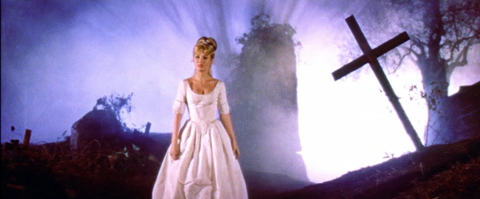
...Et mourir de plaisir is in no way a low budget production. It was filmed on French locations in the exotic format Technirama, which is actually squeezed VistaVision. Printed in Technicolor, Claude Renoir's cinematography is beautiful almost to a fault -- the look of the picture combined with Jean Prodromidès' delicate music score creates an elegant yet eerie mood. Euro-horror sirens are known for taking candles in hand for spooky scenes wandering through cobwebbed corridors. The key image of ...Et mourir de plaisir shows Carmilla, with blonde hair piled high and wearing a flowing white dress, cruising past a reflecting pool and through the trees of the Karnstein estate.
Roger Vadim puts a good directing effort into ...Et mourir de plaisir, especially when it comes to scenes between Leo, Georgia and the disturbed Carmilla. An early scene is packed with exposition, setting up the family relationships as well as the Karnstein history. The three main characters live in a bubble of their own desires. The somewhat thick-headed Count Leo doesn't realize that his cousin Carmilla is in love with him. Georgia indulges this as best she can, and remains in good humor. But she's thoughtless in her own way. Intrigued by a fox the groundskeeper has been lucky to catch, Georgia insists on making it a pet. As can be expected, the fox immediately escapes. Leo blithely instructs the groundskeeper to catch it again. Leo's not a bad fellow, as is shown when the Army informs him that the police have discovered old German mines hidden in the cemetery. Blowing them up means damaging the ruins, but Leo puts safety ahead of some old family stones. Unfortunately, Vadim includes a scene where Count Leo appears to be ogling Carmilla's nude body, when he and Georgia put her to bed one night. Mel Ferrer's vacant smile doesn't communicate anything deeper in his concern for his cousin. In screenings, audiences laugh at this moment.

...Et mourir de plaisir's handling of the character of Carmilla is sensational, especially for a film made in 1960. Annette Stroyberg's Carmilla takes on a hidden agenda. She dons Millarca's old dress to stalk ghostlike though the landscape, in a trance. She pursues the unfortunate servant Lisa (Gaby Farinon) and is in turn snooped on by the mischievous, impressionable girls Martha and Marie (Camilla Stroyberg & Nathalie Lafaurie). But the picture really heats up when the emotionally upset Carmilla sees mirror reflections in which a bright red bloodstain spreads across her dress. The red stain aligns symbolically with a red rose, and of course with the blood 'Millarca' is supposed to be craving. In this uncensored continental version Carmilla pulls down one side of her dress to show one breast completely soaked in blood -- but only in the mirror. The American version uses tamer alternate takes.
Notorious erotic scene #2 occurs in the greenhouse, where Georgia and Carmilla have fled to avoid a sudden cloudburst. Georgia pricks her finger on a rose thorn and puts it to her lips. Already behaving strangely (or aroused?), Carmilla softly embraces Georgia and kisses her, presumably to lap up the tiny spot of blood. This is the film's alleged lesbian encounter, and it's difficult to deny the intention. The two gorgeous women, the wet hair, the hallucinatory colors are all swooningly attractive. But the impact is dulled a bit knowing that the blood is what's turning Carmilla on, even though her overall mental disturbance could very well be sexual. As we've already seen, these titled rich folk are loose with their embraces, kisses and semi-intimate affections. Carmilla loves Leo and resents Georgia, yet is apparently also attracted to Georgia. Does being a modern mental-case vampire mean experiencing surreal hallucinations and baffling sexual confusion? I don't know, but the sexual confusion part is really photogenic.
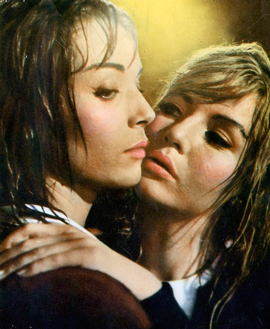
The film's third 'hot' scene is its biggest mystery, and was originally the focus of a lot of negative criticism. Georgia experiences a nightmare in which Carmilla apparently bites her neck and puts her into a coma-like state. When Carmilla closes in on the sleeping Georgia, the color drains from the image and a B&W surreal dream sequence ensues. Isolated details in shots are rendered in color, mostly bright red in keeping with the blood motif. The effect looks like a refinement of the bathtub of red blood in an otherwise B&W shot in William Castle's The Tingler.
The surreal sequence is not very good. Critics were quick to point out images recycled from Jean Cocteau's Blood of a Poet. The four or five "surreal-lite" scenes are not particularly imaginative, and neither do they have much connection with Georgia's experience. A bland 'mad surgery' scene dropped from some prints of the American version shows a nude woman on an operating table. Millarca is the mad surgeon; she announces that she's killed and replaced Carmilla, who is now a dead body draped across some chairs nearby. The dream sequence doesn't relate well to the characters and doesn't make a statement of its own. What does the medical horror setting have to do with anything?
The sequence concludes with Georgia screaming awake, and then collapsing into a deep sleep. Her nightdress, the position of her hands and the fact that we know Carmilla is hovering over / biting her brings up a discussion of a mysterious pair of scene photographs not included in any known version of this intriguing movie. 2
The photos remain a mystery but we now know that the film's American cut is different than the continental version seen here. They are really two movies made from different camera takes -- the main cast speaks English for one version, and French for the other. This European cut has some ragged editing, especially at the very beginning and end. The audio track begins more than halfway into the main titles and looks like a mistake. An annoying opening not seen in the American cut seems grafted on - instead of seeing Carmilla on a jet plane, the doctor is a passenger. He begins to relate a weird story he witnessed some time back...
I personally haven't seen the English-language cut in a long time. Instead of the doctor, Carmilla is seen traveling on the jet in the beginning. But the voiceover narration we hear appears to be that of the vampire Millarca. Since Carmilla has not yet been possessed, hearing Millarca indicates that in the English cut the supernatural aspect of the film is real and not a psychological fantasy. Web board discussions have explained that the English-language cut also extends the final scene with a crude insert of a rose losing its color, to indicate more emphatically that the curse of Millarca is not finished. The English cut is five minutes shorter. We don't know whether to believe that a reported 85- minute version ever existed. If the encoding on this disc has a 4% PAL speed-up, its 79-minute cut may actually run 83 minutes or so.
The Media Target Distribution GmbH PAL Region 2 DVD of ...und vor Lust zu Sterben is the best version of the French version of ...Et mourir de plaisir yet available, and the only one to be intact, or close to intact. I see little or no damage of any kind. It looks as if it were transferred from a surviving print in excellent condition, although contrast is a little high. Blacks clot up in some shots and the colors are sometimes rather harsh. There's no lack of color, although some scenes seem to have too much red. (At our screening, I joked that all the warm colors omitted from recent Hammer Films transfers weren't thrown away, but recycled for this transfer.) The saturation is such that a blood spot on Georgia's lips cannot be distinguished from the color of her lipstick. This same shot appears in a trailer included on the disc, without this 'invisible blood spot' problem. The first four images on this page are cropped screen grabs taken from this new German disc.
We're immediately impressed by the work of cinematographer Claude Renoir, who deals with many demanding lighting situations and always comes up with beautiful images. I'd say that the most important quality distinguishing the first wave of Euro-horror is camerawork that generates oneiric images of great beauty. Eyes without a Face, Mill of the Stone Women and The Horrible Dr. Hichcock are continually hitting us with powerful, evocative visuals.
The audio tracks for ...und vor Lust zu Sterben are noisy, especially in silent passages. The audio source sounds like a scratchy optical track. Some reels seem to have been resynchronized in ways that leave gaps between a few scenes. Just the same, Jean Prodromidès' eerie music comes across well, particularly a dramatic piano piece, identified in the movie as an old theme composed by the Karnsteins.
Media Target's presentation shows considerable effort. Trailers for the two variants of the film are present, as well as trailers for a German spy thriller, the 3-D chiller The Mask and the sexy nightclub drama Playgirl After Dark with Jayne Mansfield and Christopher Lee. It looks so good, it might be a stealth masterpiece. Its director? Terence Young.
Galleries offer the contents of pressbooks for the film and dozens of stills and lobby cards from different countries -- I can just imagine how severely Franco's Spain must have censored its version, Rosa de Sangre. We see no mention of mystery stills from cut scenes, however.
On a scale of Excellent, Good, Fair, and Poor,
...und vor Lust zu Sterben Blu-ray rates:
Movie: Excellent ---
Video: Good
Sound: Good + / -
Audio: German, French
Supplements: trailers, pressbook images, still gallery.
Deaf and Hearing Impaired Friendly?
YES; Subtitles: English
Packaging: Keep case
Reviewed: March 5, 2014
Footnotes:
 1. One of my most successful student screenings at UCLA was a 1971 Halloween triple bill of Black Sunday, Blood and Roses and The Fearless Vampire Killers. At that time those movies had been seen by practically nobody.
1. One of my most successful student screenings at UCLA was a 1971 Halloween triple bill of Black Sunday, Blood and Roses and The Fearless Vampire Killers. At that time those movies had been seen by practically nobody.
Return
2. Where these scene stills came from I have no idea; I first saw one of them in Ornella Volta's erotic horror art book Le Vampire, and the other may have first caught my eye in one of the continental coffee table books Erotisme au Cinema. What do the stills show? It's hard to say exactly. Is this rubbery blob-monster with melted facial features the true form of the Karnstein vampire 'carried' by Carmilla/Millarca? Is it the ultimate symbolic form of the phantom rose image and the bloodstain in the mirror? I wonder if in color it was originally blood red? The thing reminds me of De Maupassant's The Horla, were that demon spirit to become visible.
The blob could just be a briefly glimpsed hallucination, albeit one about a thousand times more potent than anything else in Georgia's nightmare -- or for that matter, most horror movies to this time. Whatever it is, the thing is definitely feeding on Georgia as might a vampire bat. Where in the movie was it meant to go? The position of Georgia's arms leads me to believe that the Thing- like thing was once meant to serve as the final shock image of Georgia's nightmare. Was it cut out because it was just too disturbing, and threw the whole film off balance? Or was it so gross that it offended the producer or the censors?
The motif of human features distorted by 'unholy lust' reminds me of the frightening hallucinated horror-face from Riccardo Freda's The Horrible Dr. Hichcock, made two years later. Perhaps this mystery is explained in an old issue of Midi-Minuit Fantastique. We're here in the dark, somebody out there enlighten us!
Return
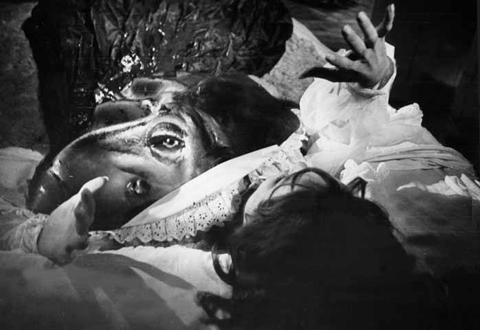
3. A friend and film restorer noted that in the little bit of the dream sequence still present in the bootlegged French web version, some shots were in full color, even though the other versions rendered them in B&W, with selective red highlights. The 2003 French TV version couldn't have been a simple cut-down from the standard print. In other words, a third distinct version of the film may exist, with at least part of the dream sequence in full color.
Return

DVD Savant Text © Copyright 2014 Glenn Erickson
See more exclusive reviews on the Savant Main Page.
Reviews on the Savant main site have additional credits information and are often updated and annotated with reader input and graphics.
T'was Ever Thus.
Return to Top of Page
|

